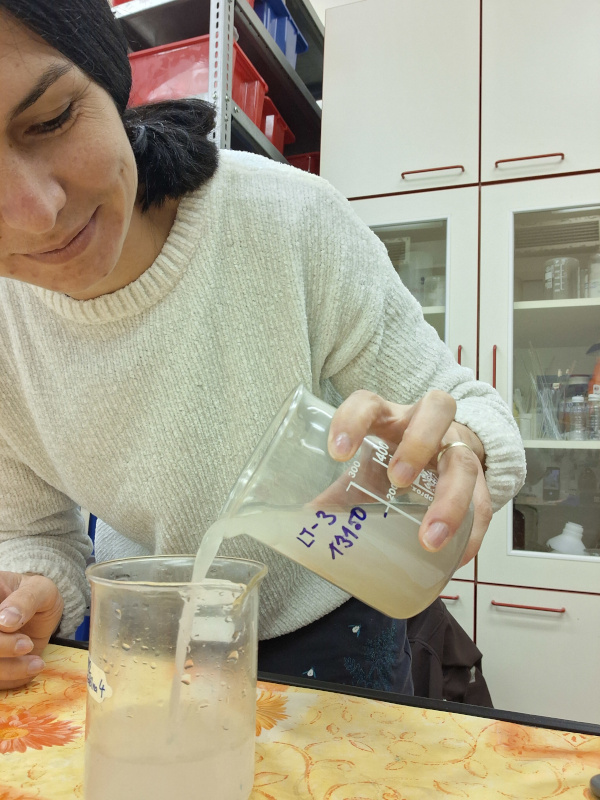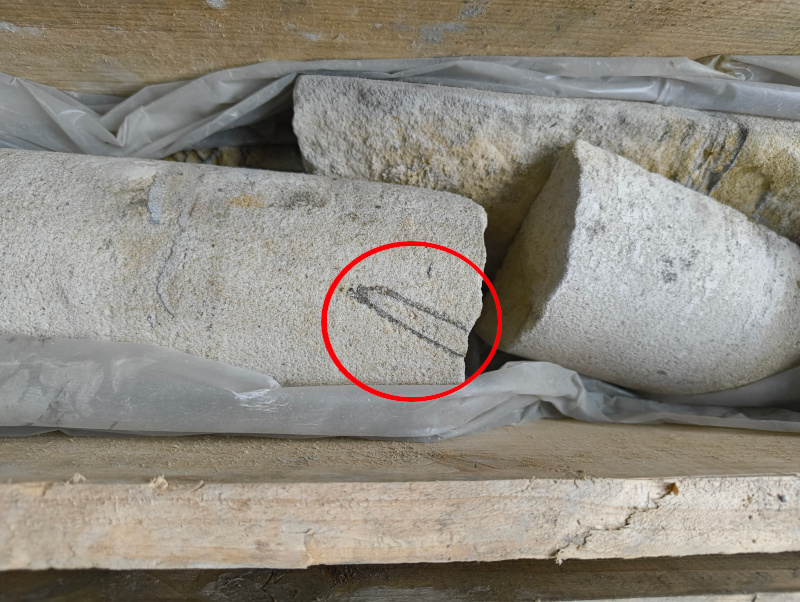Micropaleontologist Markéta Chroustová collects samples from a drill core obtained from a 516-meter-deep borehole completed at the RINGEN research center in the spring of 2025. She mainly deals with marine fossils, although one of the groups she studies, Ostracods, has both marine and freshwater representatives.
The organisms studied are divided into two main groups:
-
Microfossils: approximately 0.2–0.5 millimeters in size.
-
Nanofossils: they are smaller, measuring only a few micrometers

"The studied microscopic organisms have living representatives today. These living species differ from their Cretaceous ancestors; all groups have undergone evolutionary changes since the Cretaceous period. However, they remain similar in morphology and ecological function and still play important roles in the today´s environment. For example, calcareous nanoplankton, as part of phytoplankton, plays a key role in the storage of CO2 in the ocean," explains Markéta Chroustová.
The taxonomic classification of micro- and nanofossils is used to determine the relative age of sediments and for stratigraphic correlation, that is, comparing rock layers in different locations that may not appear related at first glance. The aim is to determine whether these layers belong to the same or similar rock bodies and to establish their age. Various characteristics can be used for stratigraphic correlation, such as rock composition, the fossil content, chemical and physical properties, or specific geological events. The method in which fossils are the determining factor is called biostratigraphy. Within the Bohemian Cretaceous Basin, this research helps geologists to determine the age of so-called biozones, i.e., rock bodies bounded by a biohorizon (the first or last occurrence of an index taxon). It allows comparison with sediments of the same age from other parts of Europe.
Paleoecological reconstructions allow us to define ancient ecosystems in greater detail. They enable us to determine, for example, what the marine environment looked like at a given time, or how temperature, environmental productivity, and other parameters changed, and how this affected microorganisms. Such research can be compared with current global changes and the responses of organisms to them. The main goal is to describe ecosystems in as much detail as possible and to specify geological periods in terms of living conditions.
Obtaining microfossils and nanofossils from rock requires special laboratory methods. To extract microfossils, the rock is crushed, soaked in water, frozen, or boiled. Glauber's salt or baking soda is added, which crystallizes in the rock and mechanically breaks it apart. The resulting material is washed on a sieve under water. Smaller particles drain away, leaving a fraction of rock fragments, mineral grains, and mainly microfossils on the sieve.
To extract nanofossils, the sediment is crushed into a fine powder. This is poured over with hydrogen peroxide, which dissolves the finer particles. A sieve cannot be used to filter the fossils from the liquid, but decantation is used instead. By decanting the liquid after a certain time from the start of sedimentation, we obtain a specific fraction of particles that have not yet settled. The sample is then dropped onto a microscope slide and studied under a microscope. Both methods are very time-consuming, but they yield valuable and interesting results.

"I focus primarily on the Mesozoic Cretaceous period within the Bohemian Cretaceous Basin. I have been working on core research at RINGEN since the beginning of 2025. As a preliminary result, I have already defined a biozone named after Foraminifera (one of the groups of microfossils) called Casidella tegulata. The aim of my work is also to place the data from the Litoměřice borehole in the context of the Bohemian Cretaceous Basin and thus create a comprehensive picture of the Cretaceous sea in space and time," explains Markéta Chroustová.
.jpg)
Markéta Chroustová represents the youngest generation of geologists at the Czech Geological Survey. However, her colleague Stanislav Čech, who began his career as a geologist in the 1970s, also visits the RINGEN research center. Unlike Markéta, he focuses on macrofossils. At the RINGEN research center, he examines marine sediments from the Cretaceous period in drill core. One of the species studied is Inoceramus, a bivalve that is a stratigraphic indicator and is used to determine the age of the sediments. Some other species of bivalves are used to describe the ecosystems of that time in detail. Their descendants still live in shallow seas today, and their occurrence is linked to specific living conditions, temperature, and water depth. Based on this, we can deduce whether cold currents from the North Sea or warm currents from the Mediterranean Sea reached the Czech Cretaceous Basin.
In addition to the remains of hard animal shells, we also find traces of organism activity. These are so-called biogenic textures – traces of climbing, digging, and drilling. For example, in the core from the Cenomanian period, we can find the remains of tunnels dug by decapod crustaceans in soft sand. To prevent the tunnels from collapsing, they lined them with clay and organic debris. Today, we can find tunnels with circular cross-sections lined with dark linings in sandstone from this period.

Mr. Čech became a geologist thanks to his love of nature. "When I was a small boy, my parents took me on a trip to Barrandov. I found a trilobite fossil there and fell completely in love with palaeontology. It hasn't changed to this day. My garage at home is full of fossils," adds Stanislav Čech, who has contributed to the creation of several geological maps of the Czech Republic during his career.
Unlike the applied research mainly carried out at the RINGEN research center, this is primary research that gathers basic information about our nature and has no practical application. In addition to dating individual periods, it helps the public discover the fascinating and beautiful organisms that lived in our area millions of years ago.







